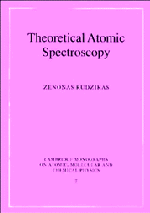Book contents
- Frontmatter
- Contents
- Preface
- Foreword to the Paperback Edition
- Introduction
- Part 1 Energy Spectrum of Many-electron Atom. Radiative and Autoionizing Transitions (Initial Formulas)
- Part 2 Foundations of the Angular Momentum Theory. Graphical Methods
- Part 3 Description of Complex Electronic Configurations
- Part 4 Second-quantization in the Theory of an Atom. Quasispin and Isospin
- Part 5 Matrix Elements of the Energy Operator
- Part 6 Electric and Magnetic Multipole Transitions
- Part 7 Calculation of Energy Spectra and Electronic Transitions in the Case of Complex Configurations
- Epilogue
- References
- Index
Preface
Published online by Cambridge University Press: 21 September 2009
- Frontmatter
- Contents
- Preface
- Foreword to the Paperback Edition
- Introduction
- Part 1 Energy Spectrum of Many-electron Atom. Radiative and Autoionizing Transitions (Initial Formulas)
- Part 2 Foundations of the Angular Momentum Theory. Graphical Methods
- Part 3 Description of Complex Electronic Configurations
- Part 4 Second-quantization in the Theory of an Atom. Quasispin and Isospin
- Part 5 Matrix Elements of the Energy Operator
- Part 6 Electric and Magnetic Multipole Transitions
- Part 7 Calculation of Energy Spectra and Electronic Transitions in the Case of Complex Configurations
- Epilogue
- References
- Index
Summary
Nothing exists except atoms and empty space; everything else is opinion.
DemocritusIt has taken a very long time for this book to appear. For many years I had in my mind the idea of publishing it in English, but practical implementation became possible only recently, after drastic changes in the international political situation. The book was started in the framework (a realistic one) of the former USSR, and finished soon after its collapse, after my motherland, the Republic of Lithuania, regained its independence.
Academician of the Lithuanian Academy of Sciences, Adolfas Jucys, initiated the creation of a group of scientists devoted to the theory of complex atoms and their spectra. Later it was named the Vilnius (or Lithuanian) school of atomic physicists, often called by his name. However, for many years the results of these studies were published largely only in Russian and, therefore as a rule they were not known among Western colleagues, particularly those in English-speaking countries. A large number of the papers were published in Russian in the main Lithuanian physical journal Lietuvos fizikos rinkinys – Lithuanian Journal of Physics, translated into English by Allerton Press, Inc. (New York) as Soviet Physics – Collection (since 1993 – Lithuanian Physics Journal).
Recently the situation has become incomparably better. There is no problem publishing the main ideas and results in prestigious international journals in English. However, it would be very useful to collect, to analyse and to summarize the main internationally recognized results on the theory of many-electron atoms and their spectra in one monograph, written in English. This book is the result of the long process of practical realization of that idea.
- Type
- Chapter
- Information
- Theoretical Atomic Spectroscopy , pp. xiii - xivPublisher: Cambridge University PressPrint publication year: 1997

